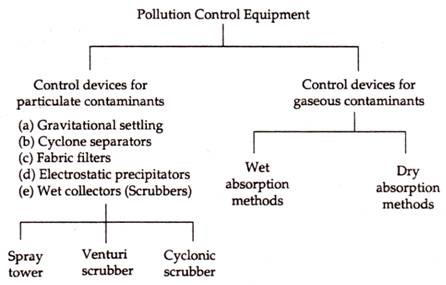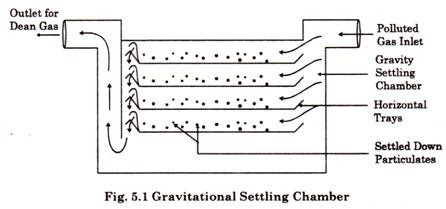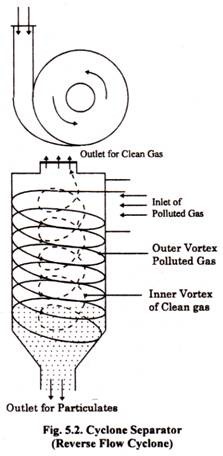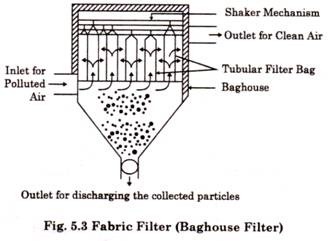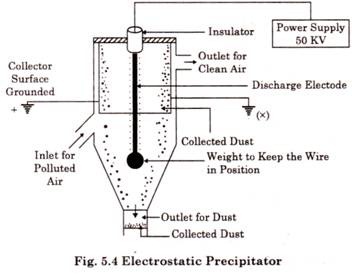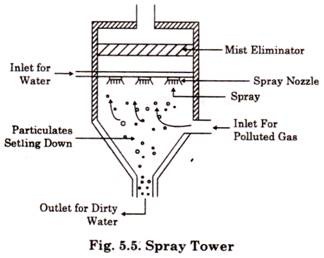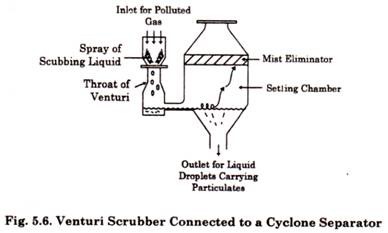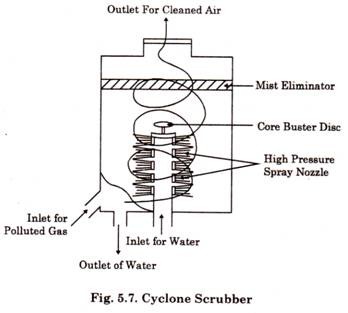Control of particulate and gaseous emission
Some of the effective methods to Control Air Pollution are as follows: (a) Source Correction Methods (b) Pollution Control equipment (c) Diffusion of pollutant in air (d) Vegetation (e) Zoning.
(a) Source Correction Methods:
Industries make a major contribution towards causing air pollution. Formation of pollutants can be prevented and their emission can be minimised at the source itself.
By carefully investigating the early stages of design and development in industrial processes e.g., those methods which have minimum air pollution potential can be selected to accomplish air-pollution control at source itself.
These source correction methods are:
(i) Substitution of raw materials:
If the use of a particular raw material results in air pollution, then it should be substituted by another purer grade raw material which reduces the formation of pollutants. Thus,
(a) Low sulphur fuel which has less pollution potential can be used as an alternative to high Sulphur fuels, and,
(b) Comparatively more refined liquid petroleum gas (LPG) or liquefied natural gas (LNG) can be used instead of traditional high contaminant fuels such as coal.
(ii) Process Modification:
The existing process may be changed by using modified techniques to control emission at source. For example,
(a) If coal is washed before pulverization, then fly-ash emissions are considerably reduced.
(b) If air intake of boiler furnace is adjusted, then excess Fly-ash emissions at power plants can be reduced.
(iii) Modification of Existing Equipment:
Air pollution can be considerably minimised by making suitable modifications in the existing equipment:
(a) For example, smoke, carbon-monoxide and fumes can be reduced if open hearth furnaces are replaced with controlled basic oxygen furnaces or electric furnaces.
(b) In petroleum refineries, loss of hydrocarbon vapours from storage tanks due to evaporation, temperature changes or displacement during filling etc. can be reduced by designing the storage tanks with floating roof covers.
(c) Pressurising the storage tanks in the above case can also give similar results.
(iv) Maintenance of Equipment:
An appreciable amount of pollution is caused due to poor maintenance of the equipment which includes the leakage around ducts, pipes, valves and pumps etc. Emission of pollutants due to negligence can be minimised by a routine checkup of the seals and gaskets.
(b) Pollution Control Equipment:
Sometimes pollution control at source is not possible by preventing the emission of pollutants. Then it becomes necessary to install pollution control equipment to remove the gaseous pollutants from the main gas stream.
The pollutants are present in high concentration at the source and as their distance from the source increases they become diluted by diffusing with environmental air.
Pollution control equipment’s are generally classified into two types:
(a) Control devices for particulate contaminants.
(b) Control devices for gaseous contaminants.
In the present book only the control devices for particulate contaminants are dealt with.
Control Devices for Particulate Contaminants:
(1) Gravitational Settling Chamber:
For removal of particles exceeding 50 µm in size from polluted gas streams, gravitational settling chambers (Fig 5.1) are put to use.
This device consists of huge rectangular chambers. The gas stream polluted with particulates is allowed to enter from one end. The horizontal velocity of the gas stream is kept low (less than 0.3 m/s) in order to give sufficient time for the particles to settle by gravity.
The particulates having higher density obey Stoke’s law and settle at the bottom of the chamber from where they are removed ultimately. The several horizontal shelves or trays improve the collection efficiency by shortening the settling path of the particles.
(2) Cyclone Separators (Reverse flow Cyclone):
Instead of gravitational force, centrifugal force is utilized by cyclone separators, to separate the particulate matter from the polluted gas. Centrifugal force, several times greater than gravitational force, can be generated by a spinning gas stream and this quality makes cyclone separators more effective in removing much smaller particulates than can possibly be removed by gravitational settling chambers.
A simple cyclone separator (Fig 5.2) consists of a cylinder with a conical base. A tangential inlet discharging near the top and an outlet for discharging the particulates is present at the base of the cone.
Mechanism of Action:
The dust laden gas enters tangentially, receives a rotating motion and generates a centrifugal force due to which the particulates are thrown to the cyclone walls as the gas spirals upwards inside the cone (i.e. flow reverses to form an inner vortex which leaves flow through the outlet). The particulates slide down the .walls of the cone and are discharged from the outlet.
(3) Fabric Filters (Baghouse Filters):
In a fabric filter system, a stream of the polluted gas is made to pass through a fabric that filters out the particulate pollutant and allows the clear gas to pass through. The particulate matter is left in the form of a thin dust mat on the insides of the bag. This dust mat acts as a filtering medium for further removal of particulates increasing the efficiency of the filter bag to sieve more sub micron particles (0.5 µm).
A typical filter (Fig 5.3) is a tubular bag which is closed at the upper end and has a hopper attached at the lower end to collect the particles when they are dislodged from the fabric. Many such bags are hung in a baghouse. For efficient filtration and a longer life the filter bags must be cleaned occasionally by a mechanical shaker to prevent too many particulate layers from building up on the inside surfaces of the bag.
(4) Electrostatic Precipitators:
The electrostatic precipitator (Fig. 5.4) works on the principle of electrostatic precipitation i.e. electrically charged particulates present in the polluted gas are separated from the gas stream under the influence of the electrical field.
A typical wire and pipe precipitator consists of:
(a) A positively charged collecting surface (grounded).
(b) A high voltage (50 KV) discharge electrode wire.
(c) Insulator to suspend the electrode wire from the top.
(d) A weight at the bottom of the electrode wire to keep the wire in position.
Mechanism of Action:
The polluted gas enters from the bottom, flows upwards (i.e. between the high voltage wire and grounded collecting surface). The high voltage in the wire ionises the gas. The negative ions migrate towards the grounded surface and pass on their negative charge to the dust particles also. Then these negatively charged dust particles are electrostatically drawn towards the positively charged collector surface, where they finally get deposited.
The collecting surface is rapped or vibrated to periodically remove the collected dust-particles so that the thickness of the dust layer deposited does not exceed 6 mm, otherwise the electrical attraction becomes weak and efficiency of the electrostatic precipitator gets reduced.
As the electrostatic precipitation has 99 + percent efficiency and can be operated at high temperatures (600°C) and pressure at less power requirement, therefore, it is economical and simple to operate compared to other devices.
(5) Wet Collectors (Scrubbers):
In wet collectors or scrubbers, the particulate contaminants are removed from the polluted gas stream by incorporating the particulates into liquid droplets.
Common wet scrubbers are:
(i) Spray Tower
(ii) Venturi Scrubber
(iii) Cyclone Scrubber
(i) Spray Tower:
Water is introduced into a spray tower (Fig. 5.5.) by means of a spray nozzle (i.e. there is downward flow of water). As the polluted gas flows upwards, the particulates (size exceeding 10 µm) present collide with the water droplets being sprayed downward from the spray nozzles. Under the influence of gravitational force, the liquid droplets containing the particulates settle to the bottom of the spray tower.
(ii) Venturi Scrubber:
Submicron particulates (size 0.5 to 5 µn) associated with smoke and fumes are very effectively removed by the highly efficient Venturi Scrubbers. As shown in Fig 5.6 a Venturi Scrubber has a Venturi shaped throat section. The polluted gas passes downwards through the throat at the velocity of 60 to 180 m/sec.
A coarse water stream is injected upwards into the throat where it gets atomised (i.e. breaks the water into droplets) due to the impact of high velocity of the gas. The liquid droplets collide with the particulates in the polluted gas stream.
The particles get entrained in the droplets and fall down to be removed later on. Venturi Scrubbers can also remove soluble gaseous contaminants. Due to the atomisation of water there is proper contact between the liquid and the gas increasing the efficiency of the Venturi Scrubber (their power cost is high because of the high inlet gas velocity).
To separate the droplets carrying the particulate matter from the gas stream, this gas-liquid mixture in the Venturi Scrubber is then directed into a separation device such as a cyclone separator.
(iii) Cyclone Scrubber:
The dry cyclone chamber can be converted into a wet cyclone scrubber by inserting high pressure spray nozzles at various places within the dry chamber (Fig. 5.7).
The high pressure spray nozzles generate a fine spray that intercepts the small particles in the polluted gas. The centrifugal force throws these particles towards the wall from where they are drained downwards to the bottom of the scrubber.
(c) Diffusion of Pollutants in Air:
Dilution of the contaminants in the atmosphere is another approach to the control of air pollution. If the pollution source releases only a small quantity of the contaminants then pollution is not noticeable as these pollutants easily diffuse into the atmosphere but if the quantity of air contaminants is beyond the limited capacity of the environment to absorb the contaminants then pollution is caused.
However, dilution of the contaminants in the atmosphere can be accomplished through the use of tall stacks which penetrate the upper atmospheric layers and disperse the contaminants so that the ground level pollution is greatly reduced. The height of the stacks is usually kept 2 to 21/2 times the height of nearby structures.
Dilution of pollutants in air depend on atmospheric temperature, speed and direction of the wind. The disadvantage of the method is that it is a short term contact measure which in reality brings about highly undesirable long range effects.
This is so because dilution only dilutes the contaminants to levels at which their harmful effects are less noticeable near their original source whereas at a considerable distance from the source these very contaminants eventually come down in some form or another.
(d) Vegetation:
Plants contribute towards controlling air-pollution by utilizing carbon dioxide and releasing oxygen in the process of photosynthesis. This purifies the air (removal of gaseous pollutant—CO2) for the respiration of men and animals.
Gaseous pollutants like carbon monoxide are fixed by some plants, namely, Coleus Blumeri, Ficus variegata and Phascolus Vulgaris. Species of Pinus, Quercus, Pyrus, Juniperus and Vitis depollute the air by metabolising nitrogen oxides. Plenty of trees should be planted especially around those areas which are declared as high-risk areas of pollution.
(e) Zoning:
This method of controlling air pollution can be adopted at the planning stages of the city. Zoning advocates setting aside of separate areas for industries so that they are far removed from the residential areas. The heavy industries should not be located too close to each other.
New industries, as far as possible, should be established away from larger cities (this will also keep a check on increasing concentration of urban population in a few larger cities only) and the locational decisions of large industries should be guided by regional planning. The industrial estate of Bangalore is divided into three zones namely light, medium and large industries. In Bangalore and Delhi very large industries are not permitted.

